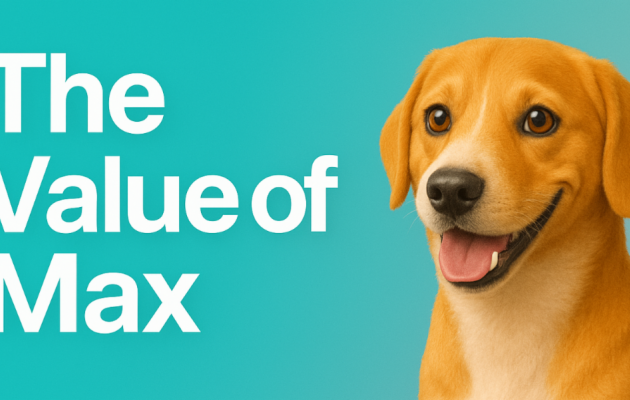A Private Adjuster's Perspective: The Value of Max

The Value of Max

Your author recognizes and acknowledges that dog and cat lovers are almost equally split (with dog lovers having a slight edge) in today’s population. This article is written with dogs as the central characters solely because your author was raised with dogs and never had the experience of receiving a cat’s love. Nevertheless, what is said here applies equally to dogs and cats (and, possibly, other animals) as well as the male and female gender.
I am sure that many of our readers can identify with the general proposition that, in our youth and in yesteryear, dogs and cats were given and called by “dog and cat” names. Names like Fido, Lucky, Rover, Rusty, Buck, Duke, King, Spot, Lassie, Lady, Scruffy were quite common.
In contrast, in 2023, the most popular dog and cat names were Charlie, Leo, Max, Jack, Vinny, Bella, Coco, Daisy, Lily, Anna, Nikki and others all bearing a remarkable resemblance to human names.
How did this come to be?
Our Ever-Evolving Feelings Towards Dogs (and Cats):
Psychology and Cultural Anthropology each have a construct known as anthropomorphism.
Simply stated, anthropomorphism is the attribution of human traits, intentions or emotions to non-human entities such as animals, gods or inanimate objects.
Putting this phenomenon into practice, we look at Max’s face and see in his eyes and the shape of his mouth a big, beautiful “smile” and, immediately, conclude that Max is so very happy with us and in his environs. We can also see at times, a “frown” leading us to feel his anger or sadness. His eyes will also, at times, convey a sense of lethargy or listlessness resulting in a run to the Vet to seek a cure for whatever is ailing our beloved Max.
When one considers the fact that: billions of dollars are spent each year in caring for our companion pets; enormous sums are being spent for burials and funerals in dedicated pet cemeteries; veterinarians’ income will soon be on par with medical doctors; divorce courts are now dealing with custody and visitation issues involving pets; there is a movement under foot to allow us to deduct from our taxes, as dependents, our pets; and, all of the other anthropomorphizing we do, there can be no doubt but that the 21st century dog and cat have become loved and totally integral part of our families.
With all of that said and this lengthy preamble, there remains the following question.
What does all of this have to do with our World of Insurance?
Pet Insurance:
In yesteryears, unless one was a true progressive in their thinking, visits to a veterinarian or animal hospital were mostly occasioned by obvious injuries to our pets (e.g. dog hit by car and bone dislocated; cat falling out of a tree and bone dislocated). Teeth were “cleaned” and nails were “shortened” naturally (e.g. dogs were given marrow bones to chew on; cats were provided with scratching posts).
In current times, such visits take place for the same reasons people seek out the services of doctors and hospitals. We seek professional help, not only for visible wounds and injuries, but when our pets appear scruffy feverish, lethargic, uninterested in food, play or activity, etc.
As we try to protect ourselves from debilitating debt due to illness and injury by purchasing medical and hospitalization insurance, so does the modern family by buying pet insurance.
One insurer advertises that it will cover our pets for accidents and injuries, common, serious and chronic illnesses, testing and diagnostics “and more”. After summarizing its extensive grant of coverage, it then proceeds to say, in essence, “buyer beware”.
“Important Disclosures: Some exclusions may apply. For example, certain coverages may be excluded due to pre-existing or chronic conditions, or hereditary or congenital disorders. Other exclusions may apply. Please refer to the exclusions section of the policy for more information. Coverage limitations from waiting periods, deductibles, coinsurance, or policy limits may also apply. Premiums may increase at renewal based on various factors like a pet’s age, breed, location or claim history depending on the plan selected.”
As with any and all insurance policies:
READ THE POLICY
Property Insurance:
Your typical homeowners insurance policy does not provide direct coverage for the loss of the family’s pet.
“4. Property Not Covered
We do not cover: …b. animals ….” (HO 00 03 03 22; Section C).
(Whether one can purchase such insurance under a DIC policy or through the services of a surplus lines broker is beyond the scope of this article).
On the other hand, your typical commercial policy does-in limited circumstances-provide direct coverage for loss of a family’s pet.
“2. Property Not Covered
Covered property does not include: …b. Animals, unless owned by others and boarded by you, or if owned by you, only as “stock” while inside of buildings; ….” (CP 00 10 10 12; Section A2).
It is to be here noted that there are several other first party policy forms available to cover the loss to or of animals including animal bailee and animal mortality coverage.
As with any and all insurance policies:
READ THE POLICY
Liability Insurance:
The availability of liability insurance to cover loss of or damage done by animals is a topic too broad to be covered in this article. A more detailed discussion of available forms will occur in a future publication.
For our immediate purposes, suffice it to say, that homeowners, commercial, professional or errors and omissions (veterinarians, dog groomers, dog walkers, dog sitters), auto (mobile veterinary clinics, groomers, animal transporters), workers compensation, umbrella and other policies will provide coverage for animal related events.
As with any and all insurance policies:
READ THE POLICY
The Value of Max:
We now turn to a discussion as to why this Article is entitled “The Value of Max”.
Simply stated: what is the value of your lost dog or cat? To put it another way, how much money should one receive when their cat or dog (or other domestic animal) is gone?
To some: their value is immeasurable; no amount of money will suffice.
To some: their value is enormous. An example: a well-known celebrity once offered a $500,000 reward, no questions asked, for the return of her stolen dogs.
To some: an amount of money sufficient to reimburse for expenses incurred and to provide for the purchase of a replacement pet will be sufficient.
Where does law and society stand on the issue of recompense?
Historically, domestic pets have been considered personal property. Emotion and sentimentality had no place in determining the value of the lost property. Award amounts were calculated by reviewing “hard” costs previously incurred (original purchase price, veterinarian bills, food costs, cost to buy a replacement pet, etc.).
Because of anthropomorphism and our inclusion of pets as “family members”, the modern trend is to not only award actual “hard” costs incurred and to be incurred but also damages for emotional distress, loss of companionship and comfort (as we do with humans).
Most states and courts still treat pets as personal property and compensate for their loss the “hard” cost way. However, one would be foolhardy not to recognize the clear trend towards the awarding of far more for such losses.
In one Maryland case, a police officer was investigating a burglary when the plaintiffs dog barked at him. The officer claimed that he felt threatened and shot the dog. The plaintiffs disputed the officer’s account and claimed that the dog was not aggressive, did not endanger him and was just barking, normally, at a stranger. A wrongful death suit was filed. The jury awarded the plaintiffs $1,260,000 which included an award of $760,000 for emotional distress.
A Connecticut jury awarded a man $202,000 for the loss of a mild-mannered St. Bernard. Other awards and settlements: $100,000 for a springer spaniel shot and killed by a neighbor; $110,000 for a terrier shot and killed by a detective.
Bottom line:
In light of the law’s direction, in order to protect one’s hard won assets, the proper form AND amount of insurance is no longer an option but rather a necessity.








